



Ship-based Robotics An Enabling Technology for Manned and Autonomous Vessels Tremough Innovation Centre,University Campus, Penryn, Cornwall 26th September 2019
Test Facilities for Ship-based Robotics Peter Back Technical Director Submarine Technology Limited 7 Mariners Way, Cowes, Isle of Wight, PO31 8PD
Contents: 1. Introduction 2. Options 3. Land Based Testing 3.1. Testing at Reduced-scale using a Motion-simulator 3.2. Testing at Full-size on Land 3.3. Other Test Facilities 4. Current and Future Trials
1. Introduction: • New designs must be thoroughly tested before being put into service • This presentation will concentrate on the facilities required to carry out function testing on motion compensated ship-mounted robotic equipment • Commissioning and initial tests can be carried out on land with the equipment fixed to a solid foundation. However, full function testing must include mounting the unit on a moving platform
2. Options: Sea Trials • Extremely expensive • Time consuming (waiting for weather/sea conditions) • Difficult to achieve consistent conditions
Options contd. Tank Testing • Expensive • Usually testing is carried out at a greatly reduced scale
Options contd. Motion Simulator • High initial build/purchase cost • It may be necessary to carry out testing at a reduced scale • It's easy to simulate the motion of different vessel types and different sea conditions
Options contd. 'Static' Testing • Relatively inexpensive • If a suitable site is available, it is possible to carry out testing at full size • Useful results can be obtained if appropriate instrumentation is fitted together with monitoring and recording equipment
3. Land Based Testing: During the development and testing of our motion compensated systems, STL has used both Motion Simulation and 'static' land based testing. These methods will be described in greater detail on the following slides.
3.1. Testing at Reduced-scale using a Motion-simulator Prior to designing our first motion compensated device, STL built a 6 axis hydraulic motion system with the following capabilities: • Pitch, Roll, Yaw: +/- 30 degrees (min) • Heave, Surge, Sway: 900mm (min) • Payload capability: 10 tonnes
Motion-simulator Description: • The Motion Platform is a variant of the classic Stewart Table and is similar to those found in flight simulators. • Each ‘leg’ consists of a hydraulic cylinder with universal joints at each end and an associated position sensor. The position sensors monitor the extension of the cylinder rods. • The extension of the cylinders may be independently controlled so that the top frame simulates the motion of the deck of a vessel.
Motion-simulator Three methods of control:- • Toggle Switches • Hand Control • Computer Control
Video: Motion Simulator Hand Control https://youtu.be/ThmZHSqKtZ0 (opens in YouTube)
The Motion Platform was used to evaluate Motion Reference Units (MRUs)
Testing the Neptune RDU
Video: Motion Platform with RDU https://youtu.be/nmxv15rvFZs (opens in YouTube)
Testing the base unit of the full size Neptune System
Video: Motion Platform with Neptune Base Unit https://youtu.be/LgXpTn0aaYU (opens in YouTube)
3.2. Testing at Full Size On Land • If the weight or size of a system prohibits the use of a Motion Simulator then useful results can still be obtained if appropriate instrumentation is fitted along with monitoring and recording equipment. • The full size Neptune Prototype is too tall and heavy to be mounted on our Motion Simulator so commissioning and initial functional testing was carried out at a suitable outdoor site.
Computer model of the test site used to check clearance from nearby obstacles and vehicular access
Installation of Neptune Base Unit
Neptune Prototype during land based testing
Video: Neptune Prototype during land trials 1 https://youtu.be/TIRsxEO0uzc (opens in YouTube)
Video: Neptune Prototype during land trials 2 https://youtu.be/x4v-qb3xSOo (opens in YouTube)
3.3. Other Test Facilities: Test rig to verify computer based Finite Element Analysis (FEA)
4. Current and Future Trials STL are currently using the Motion Platform as a test bed for a new robotic arm known as the ASSP RDU.
Autonomous Synchronised Stabilised Platform (ASSP) RDU
When land based trials have been successfully completed, the next step is to conduct sea trials Thanks for listening
Recommend
More recommend